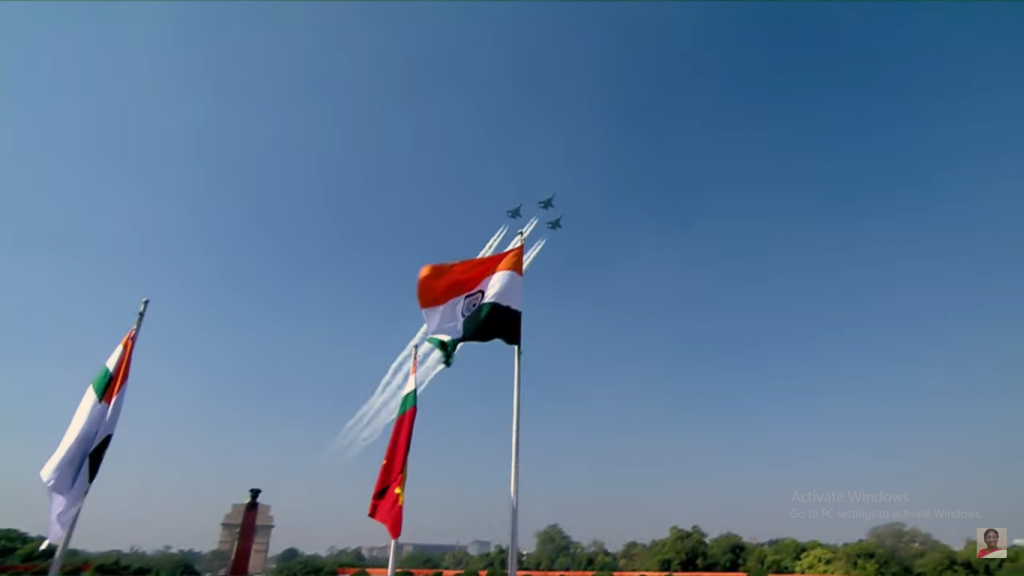New Delhi: India celebrated its 76th Republic Day Sunday with a grand display of its military might that included elite marching contingents, missiles and various indigenous weapon systems, with Indonesian President Prabowo Subianto gracing the occasion as the chief guest.
In a first, a tri-services tableau, depicting the broader spirit of “jointness” among the armed forces, rolled down Kartavya Path, the centrepiece boulevard of the national capital.
It displayed a battlefield scenario, demonstrating a synchronised operation in land, water and air with the indigenous Arjun battle tank, Tejas fighter aircraft and advanced light helicopter.
The theme of the tri-services tableau was “Shashakt aur Surakshit Bharat” (strong and secure India).
The parade commenced with President Droupadi Murmu taking the salute shortly after she and Subianto, flanked by the Indian president’s bodyguards, arrived at Kartavya Path in a “traditional buggy”.
Prime Minister Narendra Modi, Defence Minister Rajnath Singh, several other Union ministers, the country’s top military brass, foreign diplomats and senior officials were among the spectators on both sides of Kartavya Path.
The first Army contingent leading the mounted column was 61 Cavalry, led by Lieutenant Ahaan Kumar.
Raised in 1953, 61 Cavalry is the only serving active horsed cavalry regiment in the world. It was followed by nine mechanised columns and nine marching contingents.
Tank T-90 Bhishma, the NAG missile systems, the BrahMos supersonic cruise missile, the Pinaka multi-launcher rocket system, the Agnibaan multi-barrel rocket launcher, the Akash weapon system, the integrated battlefield surveillance system and all-terrain vehicle (Chetak) were among the key displays by the mechanised columns.
Light specialist vehicle Bajrang, vehicle-mounted infantry mortar system Airawat, quick reaction force vehicles Nandighosh and Tripurantak and the short-span bridging system were also on display.
The Army’s marching contingents included the Brigade of the Guards, the Jat Regiment, the Garhwal Rifles, the Mahar Regiment, the Jammu and Kashmir Rifles Regiment and the Corps of Signals.
The Indian Navy’s contingent consisted of 144 personnel led by Lieutenant Commander Sahil Ahluwalia as the contingent commander and Lt Commander Indresh Choudhary, Lt Commander Kajal Anil Bharani and Lt Devender as platoon commanders.
It was followed by the Naval tableau, depicting a strong “Aatmanirbhar” (self-reliant) Navy capable of protecting India’s maritime interests.
The tableau showcased the newly-commissioned indigenous frontline state-of-the-art combatants, including destroyer INS Surat, frigate INS Nilgiri and submarine INS Vaghsheer, highlighting India’s rapid progress in indigenous warship design and construction.
The tableau showcased the Indian Navy’s commitment to build a robust and self-sufficient defence ecosystem.
The Indian Air Force’s (IAF) contingent comprised four officers and 144 personnel, led by Squadron Leader Mahender Singh Garati. It was followed by a fly-past by three MiG-29 aircraft in “Baaz formation”.
Another highlight of the parade was the veterans’ tableau on the theme “Viksit Bharat ki Ore Sadaiv Agrasar”, a heartfelt tribute to the unwavering spirit of the ex-servicemen towards the nation.
Several veterans who brought glory to India in sports were also part of the parade.
In its tableau, the Defence Research and Development Organisation (DRDO) displayed many home-grown critical systems and technologies developed by it.
The DRDO tableau, with the theme “Raksha Kavach –? Multi-layer Protection against Multi-domain Threats”, featured quick reaction surface-to-air missile, airborne early warning and control system, 155 mm/52-calibre advanced towed artillery gun system and drone detect, deter and destroy system.
It also showcased a satellite-based surveillance system, medium-power radar Arudhra, advanced lightweight torpedo, electronic warfare system Dharashakti, laser-based directed energy weapon, very-short-range air defence system and unmanned aerial system.
It was for the first time that the indigenously-developed Pralay missile system was showcased.
A 352-member marching and band contingent from Indonesia also participated in the Republic-Day parade. This was the first time that an Indonesian marching and band contingent participated in a national-day parade abroad.
Among the contingents marching down Kartavya Path were a 148-member all-women marching contingent of the Central Reserve Police Force (CRPF), led by Assistant Commandant Aishwarya Joy M.
The Assam Rifles contingent was led by Captain Karanveer Singh Kumbhavat of 29 Assam Rifles. It comprised soldiers recruited from all over the country.
The Camel contingent of the Border Security Force (BSF) was under the command of Deputy Commandant Manohar Singh Kheechee.
The all-girls marching contingent of the National Cadet Corps (NCC) was led by Senior Under Officer Ekta Kumari of the Jammu Kashmir and Ladakh Directorate.
The all-boys marching contingent was led by Senior Under Officer Prasad Prakash Waikul of the Maharashtra Directorate.
The National Service Scheme’s (NSS) marching contingent of 148 volunteers was led by Deepak from Punjab.
PTI
